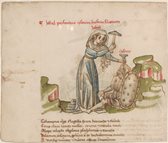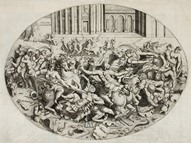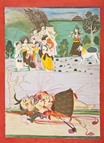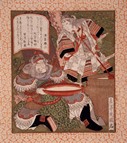







One large sculpture and one large painting
Images below are in chronological order and sized approximately to scale relative to each other. *Click images to enlarge*
1. Durga slaying the buffalo demon
*Gender of artist is unknown*
Artist: Artist unknown (Indonesian)
Medium: Volcanic stone sculpture, 33.0 x 15.0 inches
Location: Made in the province of Central Java
Time: Made in the 9th or 10th century during the Central Javanese period. Indonesian art was influenced by both Hinduism and Mahayana Buddhism from India.
Woman subject: Durga is a supreme Hindu goddess who was created by the male gods in order to defend them against the demon Mahisa. Mahisa turned into a buffalo to escape Durga. When Durga killed the buffalo manifestation, Mahisa managed to escape it by transforming into human form. Durga finally killed the demon in his human manifestation. In Indonesian culture, Durga may have been a wife of Shiva, one of the primary Hindu deities.
Things to notice: The cringing, anthropomorphic demon Mahisa has exited the vanquished buffalo under Durga's feet. Durga has eight arms holding various objects including a conch shell, a club, a bow, and an axe. One of Durga's right hands grasps the buffalo's tail via a rope, and the axe in a left hand is poised above the demon's head. In this Javanese portrayal, the buffalo and the demon aren't dead, although they are obviously defeated. This relatively gentle depiction of the episode may reflect a cultural value placed on buffalo in Java. Durga was associated with the ritual Javanese buffalo sacrifice for the protection of king and nation in modern times. It is not known whether buffalo sacrifice was a premodern, indigenous practice.
2. Judith with the head of Holofernes
*Woman artist*
Artist: Elisabetta Sirani, age 17-27 (Italian; born 1638, died 1665)
Medium: Oil on canvas, 51 x 36 inches
Location: Painted in Bologna
Time: The date Sirani painted this work is unknown. Her short career lasted only 10 years. She began painting professionally in 1655 at the age of 17 and continued until her death in 1665 at the age of 27. It is suspected that she died from bleeding stomach ulcers she developed from her workaholic habits. By the mid-17th century, Bologna already had an impressive record as a place where women attended the university and several women had made names for themselves as artists.
Woman subject: Judith's story is told in the Judeo-Christian Bible. In the 5th century B.C., the Assyrian army led by Holofernes invaded Judea. The army surrounded the city of Bethulia and attempted to starve it out. After 34 days, Bethulia was on the brink of surrender. The widow Judith put on her most beautiful clothes and, accompanied by her maid, approached the enemy camp. Judith pretended to be an informer with knowledge of a secret route to the city. Holofernes, enthralled with her beauty, invited her to dine with him. Judith flirted with him but evaded his attempts to seduce her. Finally, drunk, Holofernes passed out. Judith then cut off his head with his own sword. The Israelites defeated the Assyrians: Judith was a heroine.
Things to notice: Sirani painted in the Baroque style. Judith is lifting Holofernes' head -- which already has the pallor of death -- by the hair. She is about to place the head in a cloth held by her maid. Notice how Sirani's brushwork creates contrasting textures between Judith's white blouse and the other fabrics in the painting.
Additional information: As a woman, Sirani didn't have access to formal art training and therefore was unable to study anatomy or paint from nude models. Her father, a minor painter, taught her. Sirani nonetheless became a successful history painter. She also established a school where she taught women art students, providing opportunities for female artists who didn't have male relatives to instruct them. She painted with incredible speed, producing approximately 200 paintings during her short life. Her aristocratic patrons included members of the Medici family. Sirani concentrated on religious and historical subjects and was highly successful.
Smaller works
Images below are in chronological order and sized approximately to scale relative to each other (three times the scale of the images above). *Click images to enlarge*
3. Athena
*Gender of artist is unknown*
Artist: Artist unknown (Etruscan)
Medium: Bronze sculpture, 6.6 inches tall
Location: Made in Etruria
Time: Made around 500 B.C. to 450 B.C., at the end of the Archaic period in Etruria. Etruria roughly corresponds to the region known as Tuscany in modern Italy. The nation's trade with Greece was reflected in Greek influence on Etruscan material culture, which featured both Greek and Etruscan deities.
Woman subject: Athena is the Greek goddess of war and wisdom. She is the daughter of Zeus, born directly out of his forehead. She was immensely popular in ancient Greek culture. At about the same time that this tiny statue was made, the sculptor Phidias created a 30-foot-tall bronze of Athena for the Acropolis in Athens. The Etruscan equivalent to Athena was Menrva (the Roman version was Minerva).
Things to notice: The figure originally held a spear in her right hand and a shield on her left arm. As in virtually all depictions of Athena, she is wearing her helmet and her body armor, or aegis, decorated with a Gorgon's head on the front. Based on its size, this is probably a votive figure. The striding pose is typical of Etruscan sculpture.
4. Jael killing Sisera
*Gender of artist is unknown*
Artist: Artist unknown (Austrian)
Medium: Drawing, pen and ink with watercolor on laid paper, 6.1 x 7.1 inches
Location: Made in Austria
Time: Made around 1460, during the early Renaissance. The Austrian House of Habsburg had begun its long dynastic domination in Europe. Frederick V was the king of Germany and the Holy Roman emperor (as Frederick III).
Woman subject: Sisera is described in the Judeo-Christian Book of Judges as a general for the king of Hazor in the 12th century B.C. Sisera lost a battle with the Israelite army and fled from the scene. He ended up at Jael the Kenite's tent. Jael gave him milk and let him rest, implying he would be safe there (the Kenites had no quarrel with the king of Hazor). After he fell asleep, she killed him by driving a tent peg through his skull. Jael is celebrated as a heroine of Israel even though she wasn't an Israelite.
Things to notice: Five different paint colors are evident on this drawing. Sisera appears diminutive compared to Jael. Jael smiles as she positions the tent peg on his temple. The drawing is a page from a manuscript. The Latin caption in red at the top of the drawing translates to "Jael perforated the enemy Sisera." The text at the bottom incongruously describes the crucifixion of Christ.
5. Hester, Judith and Jael
Artist: Hans Burgkmair I, age 43 (German; born 1473, died 1531)
Medium: Woodcut print, 7.5 x 5.1 inches
Location: Made in Augsburg
Time: Printed in 1516, at the peak of Burgkmair's career. Along with several other prominent print designers, Burgkmair worked on a series of commissions for the Habsburg emperor Maximilian I beginning in 1509 until the emperor's death in 1519. The resulting woodcuts illustrated Maxmilian's ancestry, autobiography, and political career. Burgkmair collaborated with the woodcutter Jost de Negker, who also worked on the Maxmilian commissions, to create innovative chiaroscuro woodblock prints.
Woman subject: These three Jewish heroines appear in the Judeo-Christian Bible. The warriors in this image are Judith (center) and Jael (right). (Hester, at left and also known as Ester or Esther, was the Jewish queen consort of the Persian king Ahasuerus. She is an important Jewish heroine but not a warrior.) Judith was a widow in 5th-century B.C. Judea who saved her city from the Assyrians. She went into the Assyrian camp, pretending to be an informer. The commander Holofernes tried to seduce her but passed out drunk. Judith then cut off his head with his own sword. Jael was a Kenite who killed General Sisera after he fled a battle with Israeli forces in the 12th century B.C. Jael offered the exhausted general safe haven in her tent. Once he fell asleep, she drove a tent peg through his head.
Things to notice: Burgkmair was a Renaissance artist. This work was issued as one of a set of six woodcuts designed by Burgkmair and executed by Jost de Negker titled Three Good Men and Women of the Christians, of the Jews, and of the Pagans. Each of the six prints depicts a famous trio of men or women. The caption in German at the top of this example translates as "Three Good Jewish Women," even though Jael isn't Jewish. Judith, in the center, is listening attentively while Queen Hester speaks. Judith holds Holofernes' sword in her right hand and grasps the hair of Holofernes' severed head with her left. Like Judith, Jael (at right) holds her murder weapons: a tent peg and mallet. Three shields with different emblems are interspersed with the women. Compare this Renaissance print by Burgkmair side-by-side with Sirani's Baroque oil painting of Judith. (Note that the print is three times the scale of the painting in the comparison.) How are the different art styles demonstrated in the approaches to their common subject? Do you find one of them more emotionally evocative than the other?
6. Battle of the Amazons
Artist: Enea Vico, age 20 (Italian; born 1523, died 1567)
Medium: Engraving, 8.5 x 11.6 inches
Location: Made in Rome
Time: Printed in 1543. Vico had been studying in Rome for a couple of years and had just finished his first series of 24 engravings. He was a scholar of antiquities and made prints of ancient Greek and Roman statues, medals, cameos, and friezes throughout his career.
Woman subject: In Greek mythology, the Amazons were an alternate society somewhere far away, where gender roles were reversed. In fact, the Amazon nation was composed entirely of women warriors. The Greek heroes Heracles and Theseus both fought with the Amazons. One of Heracles' twelve labors -- a set of tremendously difficult and dangerous quests imposed upon him by his rival, Eurystheus -- was to obtain the girdle of Hippolyta, queen of the Amazons. Clashes between the Greeks and the Amazons were a favorite theme in ancient Greek art. The series of carved metopes on the west side of the Parthenon is an Amazonomachy
Things to notice: The classical subject and frieze-like composition of this work reflect Vico's interests. Vico's treatment is in the Mannerist style. The oval boundary accentuates the piece's sense of movement. The drama of the battle scene is heightened by the chaotic intermingling of figures. But some of the hand-to-hand combat between Greek and Amazon warriors could double as caresses in a different context. The plaque in the foreground of the engraving, under the kneeling horse, contains Vico's initials. The title of the work is in the distance, just below the fragment of horizon, in Latin.
7. The gods adoring Durga after her defeat of a demon
*Gender of artist is unknown*
Artist: Artist unknown (Indian)
Medium: Drawing, opaque watercolor and gold on paper, 20.0 x 15.0 inches
Location: Made in Chhatarpur in Bundelkhand (i.e. the state of Madhya Pradesh)
Time: Made around 1775, towards the end of the Muslim Mughal reign of Bundelkhand. The Hindu Marathas would control the region within twenty years. This work is a folio from a copy of the Devimahatmya, a Hindu religious text.
Woman subject: The male Hindu gods created the goddess Durga to defend them against the demon Mahisa. Mahisa turned into a buffalo in an attempt to escape Durga. When Durga killed the buffalo manifestation, Mahisa managed to escape it by transforming into human form. But it was no use. Durga finally killed the demon in his anthropomorphic form.
Things to notice: In this graphic image, blood spurts fountain-like from Mahisa's chest and the stumps of his severed limbs and pools around his body. Durga and her customary lion companion meet with the grateful gods in the background. The elephant-headed god is Ganesha. The god with four white-bearded heads is Brahma. The very pale god with a third eye on his forehead and a cobra draped around his neck is Shiva. Surya is the god with sun rays surrounding his head. View this Indian drawing of Durga side-by-side with the Javanese sculpture of Durga made approximately 900 years earlier. How do these works express the warrior and women identities of Durga? How do they convey her victory over Mahisa?
8. Tomoe Gozen and Fan Kuai
Artist: Yashima Gakutei, age about 38 (Japanese, born about 1786, died 1868)
Medium: Color woodcut print, surimono, brass, mica, siver, and gold, 8.3 x 7.4 inches
Location: Made in Japan
Time: Printed in 1824, during the shogunate established by Tokugawa Ieyasu in 1600. Japan was isolated from the West: Westerners and Christianity were banned. Gakutei began his career in his twenties illustrating novels and then anthologies of kyōka -- a genre of witty poems composed in 31 syllables. He also composed his own kyōka. Four years before this print was made, Gakutei began designing the illustrations for kyōka collections and surimono.
Woman subject: It isn't certain whether Tomoe Gozen was a real person or is completely legend. She appears in the Japanese epic Heike Monogatari (The Tale of the Heike). Tomoe is renowned for her valor and zeal in battle and her skill with horses. She is also admired for her beauty and loyalty to her husband, Kiso no Yoshinaka, a member of the Minamoto clan. The Minamoto and Taira families waged a war for control of Japan in the late 12th century. Tomoe fought at her husband's side as a captain in his army. The Chinese warrior Fan Kuai was a general more than a millennium earlier, around 200 B.C. He thwarted an attempted assassination of Emperor Gaozu (also known as Liu Bang).
Things to notice: Fan Kuai holds an enormous cup of saké, served up by Tomoe Gozen. Gakutei was one of the foremost surimono artists. The bordered text contains three poems in the witty kyōka style about the Boy's Day Festival, an event featuring warrior dolls. The third poem puns on Tomoe Gozen's name by mentioning tomoe roof tiles, named after the spiralling comma (tomoe) in their decorative design. Gakutei's signature is at the bottom right. Compare the three depictions of women soldiers side-by-side. How have artists' portrayals of women soldiers changed over time? How does this reflect changing societal perceptions of women soldiers?
Image sources:
1. Durga slaying the buffalo demon. Sculpture. Los Angeles County Museum of Art (LACMA). Los Angeles. 13 Jan. 2014. http://www.lacma.org/
2. Sirani, Elisabetta. Judith with the head of Holofernes. Painting. The Walters Art Museum. Baltimore. 5 Nov. 2013. http://thewalters.org/
3. Athena. Sculpture. The Walters Art Museum. Baltimore. 19 Sept. 2013. http://thewalters.org/
4. Jael killing Sisera. Drawing. National Gallery of Art. Washington. 13 Jan. 2014. https://images.nga.gov/
5. Burgkmair, Hans, I. Hester, Judith and Jael. Print. National Gallery of Art. Washington. 13 Jan. 2014. https://images.nga.gov/
6. Vico, Enea. Battle of the Amazons. Print. Los Angeles County Museum of Art (LACMA). Los Angeles. 13 Jan. 2014. http://www.lacma.org/
7. The gods adoring Durga after her defeat of a demon. Drawing. Los Angeles County Museum of Art (LACMA). Los Angeles. 13 Jan. 2014. http://www.lacma.org/
8. Gakutei, Yashima. Tomoe Gozen and Fan Kuai. Print. Los Angeles County Museum of Art (LACMA). Los Angeles. 13 Jan. 2014. http://www.lacma.org/